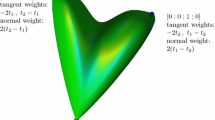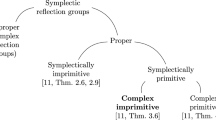Abstract
We study properties of the Hirzebruch class of quotient singularities ℂn/G, where G is a finite matrix group. The main result states that the Hirzebruch class coincides with the Molien series of G under suitable substitution of variables. The Hirzebruch class of a crepant resolution can be described specializing the orbifold elliptic genus constructed by Borisov and Libgober. It is equal to the combination of Molien series of centralizers of elements of G. This is an incarnation of the McKay correspondence. The results are illustrated with several examples, in particular of 4-dimensional symplectic quotient singularities.
Article PDF
Similar content being viewed by others
Avoid common mistakes on your manuscript.
References
M. F. Atiyah, R. Bott, The moment map and equivariant cohomology, Topology 23 (1984), 1–28.
P. Aluffi, Grothendieck classes and Chern classes of hyperplane arrangements, Int. Math. Res. Not. IMRN 2013 (2013), no. 8, 1873–1900.
P. Aluffi, L. C. Mihalcea, Chern classes of Schubert cells and varieties, J. Algebraic Geom. 18 (2009), no. 1, 63–100.
M. Andreatta, J. A. Wiśniewski, 4-dimensional symplectic contractions, Geom. Dedicata 168 (2014), 311–337.
V. V. Batyrev. Non-Archimedean integrals and stringy Euler numbers of log-terminal pairs, J. Eur. Math. Soc. (JEMS) 1 (1999), no. 1, 5–33.
P. Baum, Fixed point formula for singular varieties, in: Current Trends in Algebraic Topology, Part 2 (London, Ont., 1981), CMS Conf. Proc., Vol. 2, Amer. Math. Soc., Providence, RI, 1982, pp. pages 3–22.
P. Baum, A. Connes, Chern character for discrete groups, in: A fête of Topology, Academic Press, Boston, MA, 1988, pp. 163–232.
P. Baum, W. Fulton, G. Quart, Lefschetz-Riemann-Roch for singular varieties, Acta Math. 143 (1979), no. 3–4, 193–211.
T. Bridgeland, A. King, M. Reid, The McKay correspondence as an equivalence of derived categories, J. Amer. Math. Soc. 14 (2001), no. 3, 535–554 (electronic).
L. A. Borisov, A. Libgober, Elliptic genera of toric varieties and applications to mirror symmetry, Invent. Math. 140 (2000), no. 2, 453–485.
L. Borisov, A. Libgober, Elliptic genera of singular varieties, Duke Math. J. 116 (2002), no. 2, 319–351.
L. Borisov, A. Libgober, McKay correspondence for elliptic genera, Ann. of Math. (2) 161 (2005), no. 3, 1521–1569.
G. Bellamy, T. Schedler, On the (non)existence of symplectic resolutions for imprimitive symplectic reection groups, ArXiv e-prints, September 2013.
J.-P. Brasselet, J. Schürmann, S. Yokura, Hirzebruch classes and motivic Chern classes for singular spaces, J. Topol. Anal. 2 (2010), no. 1, 1–55.
N. Berline, M. Vergne. Classes caractéristiques équivariantes. Formule de localisation en cohomologie équivariante, C. R. Acad. Sci. Paris Sér. I Math. 295 (1982), no. 9, 539–541.
M. Brion, M. Vergne. An equivariant Riemann-Roch theorem for complete, simplicial toric varieties, J. Reine Angew. Math. 482 (1997), 67–92.
A. Campillo, F. Delgado, S. M. Gusein-Zade. Poincaré series of a rational surface singularity, Invent. Math. 155 (2004), no. 1, 41–53.
K. Chandrasekharan, Elliptic Functions, Grundlehren der Mathematischen Wissenschaften, Vol. 281, Springer-Verlag, Berlin, 1985.
S. E. Cappell, L. G. Maxim, J. Schürmann, J. L. Shaneson, Equivariant characteristic classes of singular complex algebraic varieties, Comm. Pure Appl. Math. 65 (2012), no. 12, 1722–1769.
A. M. Cohen, Finite quaternionic reflection groups, J. Algebra 64 (1980), no. 2, 293–324.
M. Donten-Bury, J. A. Wiśniewski, On 81 symplectic resolutions of a 4-dimensional quotient by a group of order 32, arXiv:1409.4204 (2014).
P. Donovan, The Lefschetz-Riemann-Roch formula, Bull. Soc. Math. France 97 (1969), 257–273.
W. Fulton, Intersection Theory, 2nd ed., Ergebnisse der Mathematik und ihrer Grenzgebiete. 3. Folge. A Series of Modern Surveys in Mathematics, Vol. 2 Springer-Verlag, Berlin, 1998.
F. Hirzebruch, Neue Topologische Methoden in der Algebraischen Geometrie, Ergebnisse der Mathematik und ihrer Grenzgebiete (N.F.), Heft 9. Springer-Verlag, Berlin, 1956.
J. Huh, Positivity of Chern classes of Schubert cells and varieties, J. Algebraic Geom. 25 (2016), no. 1, 177–199.
D. Huybrechts, Complex Geometry, An introduction, Universitext. Springer-Verlag, Berlin, 2005.
Y. Ito, M. Reid, The McKay correspondence for finite subgroups of SL(3, C), in: Higher-dimensional Complex Varieties (Trento, 1994), de Gruyter, Berlin, 1996., pp. 221–240.
D. Kaledin, McKay correspondence for symplectic quotient singularities, Invent. Math. 148 (2002), no 1, 151–175.
A. Libgober, Elliptic genus of phases of N = 2 theories, Comm. Math. Phys. 340 (2015), no. 3, 939–958.
M. Lehn, C. Sorger, A symplectic resolution for the binary tetrahedral group, in: Geometric Methods in Representation Theory. II, Sémin. Congr., Vol. 24, Soc. Math. France, Paris, 2012, pp. 429–435.
J. McKay, Graphs, singularities, and finite groups, in: The Santa Cruz Conference on Finite Groups (Univ. California, Santa Cruz, Calif., 1979), Proc. Sympos. Pure Math., Vol. 37, Amer. Math. Soc., Providence, RI, 1980, pp. 183–186.
M. Mikosz, A. Weber, Equivariant Hirzebruch class for quadratic cones via degenerations, J. Singul. 12 (2015), 131–140.
T. Ohmoto, Equivariant Chern classes of singular algebraic varieties with group actions, Math. Proc. Cambridge Philos. Soc. 140 (2006), no. 1, 115–134.
A. Pedroza, L. W. Tu, On the localization formula in equivariant cohomology, Topology Appl. 154 (2007), no. 7, 1493–1501.
M. Reid, McKay correspondence, arXiv:alg-geom/9702016 (1997).
M. Saito, Mixed Hodge complexes on algebraic varieties, Math. Ann. 316 (2000), no. 2, 283–331.
M. Verbitsky, Holomorphic symplectic geometry and orbifold singularities, Asian J. Math. 4 (2000), no. 3, 553–563.
W. Veys, Stringy zeta functions for Q-Gorenstein varieties, Duke Math. J. 120 (2003), no. 3, 469–514.
R. Waelder, Equivariant elliptic genera, Pacific J. Math. 235 (2008), no. 2, 345–377.
R. Waelder, Equivariant elliptic genera and local McKay correspondences, Asian J. Math. 12 (2008), no. 2, 251–284.
A. Weber, Equivariant Chern classes and localization theorem, J. Singul. 5 (2012), 153–176.
A. Weber, Equivariant Hirzebruch class for singular varieties, Selecta Math. (N.S.) 22 (2016), no. 3, 1413–1454.
A. Weber, Hirzebruch class and Bia lynicki-Birula decomposition, Transform. Groups 22 (2017), no. 2, 537–557.
Author information
Authors and Affiliations
Corresponding author
Rights and permissions
Open Access This article is distributed under the terms of the Creative Commons Attribution 4.0 International License (http://creativecommons.org/licenses/by/4.0/), which permits unrestricted use, distribution, and reproduction in any medium, provided you give appropriate credit to the original author(s) and the source, provide a link to the Creative Commons license, and indicate if changes were made.
About this article
Cite this article
DONTEN-BURY, M., WEBER, A. EQUIVARIANT HIRZEBRUCH CLASSES AND MOLIEN SERIES OF QUOTIENT SINGULARITIES. Transformation Groups 23, 671–705 (2018). https://doi.org/10.1007/s00031-017-9452-7
Published:
Issue Date:
DOI: https://doi.org/10.1007/s00031-017-9452-7




